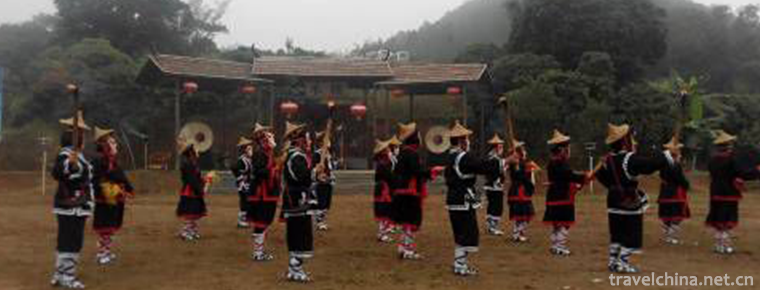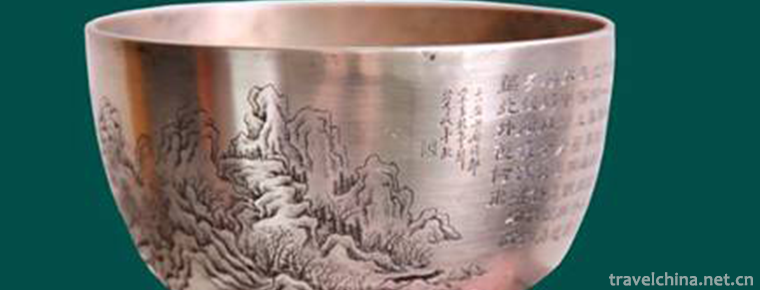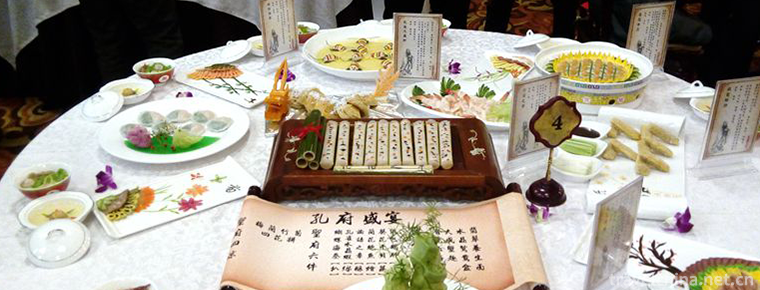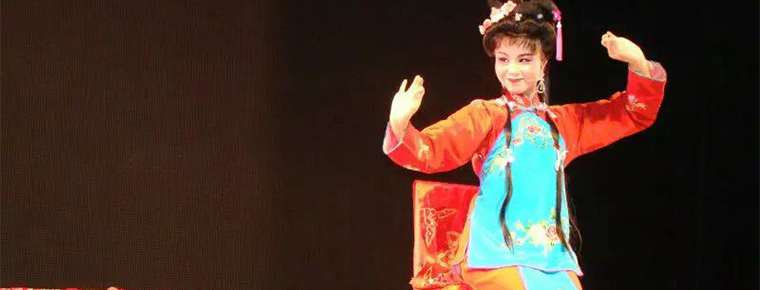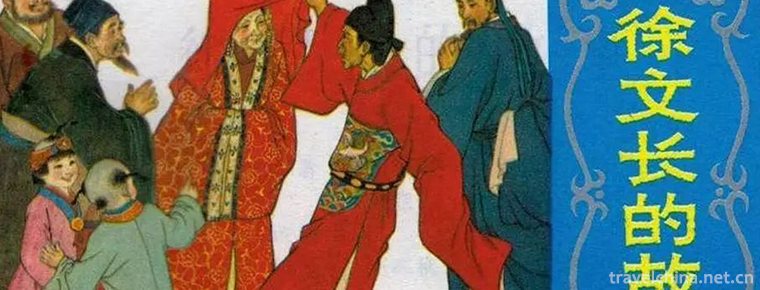Dong embroidery
Dong embroidery
Dong embroidery is an important branch of Chinese minority embroidery, which uses a needle to puncture and attaches various colored silk or cotton threads to the surface of the fabric to form various patterns. This technique is not limited by the warp and weft structure of the bottom cloth, and can give free play to the author's ideas and artistic talents. Because of the different embroidery techniques, embroidery costumes show different characteristics . They are rich in variety, novel in shape and gorgeous in color, and have a far-reaching impact on the embroidery technology in Southwest China.
On May 23, 2011, Dong embroidery was approved by the State Council and listed in the third batch of national intangible cultural heritage list.
Historical origin
Southeastern Guizhou is a hard to reach and mysterious place. There are Miao, Dong, Yao, Zhuang and Han nationalities living in Tongle Township, Sanjiang Dong Autonomous County. They have created a splendid culture here. Whether it is material wind and rain bridge, hanging foot tower, ancient well, ancient post road, or immaterial Dong opera, Dong song, Dong embroidery, all have fatal attraction. Especially Dong embroidery, simple and natural, colorful.
Dong embroidery is a branch of the excellent cultural heritage of ethnic minorities. After industrialization, it can benefit more than 40,000 ethnic people in Tongle and solve the employment problem of about 10,000 women. Investment in certain funds to industrialize embroidery plays an important role in standardizing embroidery industry, inheriting and promoting national culture, and is one of the effective measures to promote the development of Tongle spiritual civilization.
Dong embroidery is a combination of ornamental and practical technology. Embroidery not only has exquisite patterns, but also has high decorative value. Its repeated embroidery process can also increase the durability of clothing. Dong embroidery is the product of farming culture.
Dong embroidery is the intangible cultural heritage of Guangxi. This traditional craft, which integrates textile, printing and dyeing, paper-cut and embroidery, is mastered by many local women. Since ancient times, the masses here have worn very distinctive clothes, especially Dong women, with self-woven white headscarves on their heads, paired bodices on their upper bodies, wide lace on their cuffs, lace on their feet, forks and forks, and a chest pocket on their breasts. Because their parts are the places where they can display their skills most, there are many kinds of embroidery, some embroidered with dragons robbing treasures, and some embroidered with money. Hulu, some embroidered with rich peony, some embroidered with peacock screen and other patterns, these are Dong embroidery with strong primitive interest. There are many works of art in Dong embroidery, such as headscarf pattern, baby strap, women's chest pocket, cloth shoes, insoles, cigarette bags, bag embroidery and so on.
Techniques and Modeling
Since the development of Dong embroidery, a folk craft, a set of skilled and systematic production process has been formed. Embroidery is an indispensable part of Dong costumes, from hats that children must wear after birth, chest pockets hanging on their bodies, straps on their backs to the edges of their jackets, forks, men's legs, women's shoes, belly pockets... Neither can do without embroidery. Long-term, repeated labor has made their technology reach an excellent level and made it develop into an art.
Paper cutting techniques
In order to complete an embroidery work of Dong nationality, the first step is to cut paper, that is, to cut out all kinds of patterns with paper, and then to embroider according to the patterns. Paper-cut artists use small scissors to cut out individual patterns on a blank piece of cardboard according to the patterns constructed in their minds. Because the patterns are used for decoration of clothing, the patterns are small and delicate, which is different from the large and complicated patterns of paper-cut in the north. In addition, with regard to the change of patterns, Boas pointed out: "In the case that any decorative pattern must be arranged in a certain area, craftsmen are often unwilling to cut off some parts of their painted patterns due to the limitation of area, but prefer to change the patterns and put them in a limited frame as far as possible." The accommodation area of Dong embroidery is also limited, so paper-cut artists usually cut patterns in strips. When the area is insufficient, the patterns will be deformed. For example, a flower with branches and leaves, in order to have enough space, it will bend the branches of the flowers around the flowers, but also make the pattern more three-dimensional. The cut patterns are mostly the outlines of simple flowers, branches and vines, birds and bees, which are common in daily life. The more complex patterns are the Phoenix called Golden Chicken by Dong people. In addition to independent patterns, sometimes they are cut with a certain situation story, and the local people give them their own interpretation. For example, at the home of a young pregnant woman, we saw some "unconventional" and dynamic patterns like monkeys stealing peaches and mice climbing trees on the straps she had prepared for her upcoming children. Because there is no pen to delineate any shape before paper-cutting, as long as it is slightly deviated or too long or too short, the pattern can not be repaired, that is, a failed work, so it is entirely dependent on the artist's skilled skills and good image thinking, composition ability. Appreciating paper-cut works requires not only smooth lines and rounded edges, but also regular and realistic shapes. Of course, paper-cut, to a large extent, is the result of decades of repeated practice. Relatively speaking, the pattern has not changed much. Naturally, we can master the free use of skills and standardized actions. In a village office with more than 3,000 people, there are generally only about 10 highly skilled paper-cut artists, and most of them are older women. Girls can start learning embroidery at the age of eleven or twelve, but they don't start learning paper-cutting until they are in their thirties. On the other hand, because the paper-cut speed is faster, can create a large number of works in a short time for others to use, and embroidery must spend more time and energy, so people will focus on embroidery.
Embroidery techniques
By pasting the paper-cut pattern onto the cloth strip, embroidery can begin. Only green, red and yellow are the colours of the cloth strips. In embroidery, the left hand fixes the cloth strip, the right hand freely goes up and down needles. For local artists who need to embroider everyday, they will keep the nails of the left thumb long, so as to better fix the cloth strip and needle. Then the needle is pierced from the back at an angle of about 60 degrees, the thread is covered on the surface of the paper-cut pattern, and the needle is pierced into the back at the same angle. In order to make the embroidery surface smooth, symmetrical and fine, it is necessary to keep the distance of the line equal and the tension uniform in each operation. In choosing and matching embroidery colors, they are basically allocated according to the original colors of things. They are mainly red, green and blue. Local people call such colors very happy and beautiful, and form a fixed pattern. These three kinds of colors are the brightest, most striking and most stimulating of natural plant and animal colors, and then they are combined with the color of cloth strips, showing a colorful effect.
Composition
In the basic sensory aesthetics of human beings, it is always easy to reject the messy things, and tend to appreciate the orderly, orderly and pleasant things. The construction of works of art usually follows certain rules, and the composition of Dong embroidery strictly follows the principle of symmetry. First, the hems, forks, cuffs on the left and right sides of the jacket and the legging patterns on the left and right feet are symmetrical in color, style, structure and position of the arrangement. Secondly, in a larger embroidery work, also abide by the principle of symmetry. Take a child's strap cover for example. The back strap cover is square, with four embroidery tapes around it. The left and right sides are symmetrical, the upper and lower sides are symmetrical, and the four corners are composed of four triangles. The figure on the left and right sides above is symmetrical, and the other two sides below are symmetrical. The middle part of the back strap cover is composed of eight small circles, a large circle around the center. The eight small circles form four groups of symmetry with their 180 degrees angle. No matter how small the pattern is, whether it is a leaf or a branch, the corresponding identical pattern can be found from the other side of the symmetry. Because of the small pattern and more paper-cut, the artist will first look for a long belt or the center point in a circle when arranging the pattern, and then arrange symmetrically outward in turn. From the composition of the strap cover, we can see the local people's demand and pursuit of symmetry.
Every nation and group has its own specific style of art. Although the details are different, the overall internal style is fixed. People are always accustomed to depending on their familiar styles, whether it is the use of daily necessities or the external form of things. Once fixed, it is difficult to accept new changes. On the one hand, it is because of inconvenience in use, on the other hand, it is also because of the psychological security needs. New things always take a long time to be accepted by people, so people prefer to choose a long time. Conservative period is a mode, innovative thinking will naturally be limited. According to an interview with the oldest local embroidery artist (82 years old), at least in her embroidery works, which she had been exposed to and created since childhood, there was basically no change until 2012. The style of embroidery is decided by paper-cut, and the paper-cut of a village is basically made by these artists (others are purchased from these artists). Therefore, it can be said that the overall style and style of embroidery are determined by these artists.
Dong embroidery
Chen Xianyue was born in Pingqiu Village, Pingqiu Town, Jinping County, in 1964. Both her grandmother and mother are well-known local Dong embroidery experts. When Chen Xianyue was 12 years old, her frail and sick father died. The burden of her family lay on her mother. As a child, she had to drop out of school and go home to assume the responsibility of her family. Digging fields, cutting firewood, feeding pigs, she is good at everything. In her spare time, she began to ask her mother to teach her embroidery. In just two years, she learned all her mother's embroidery skills. Chen Xianyue said: "For Dong girls, there is no special teacher to learn embroidery, relying on a person's imitation ability and understanding, as well as diligence and practice." After learning the embroidery skills mastered by his mother, Chen Xianyue was not satisfied. She began to seek advice from other embroidery experts in the village, and learned how to make Dongjia straps, embroidered shoes, baby silver caps, etc. After getting married, Chen Xianyue did not put down her embroidery needle, and began to learn the production techniques of Dong Native Cloth. "Dong embroidery is all embroidered on the local cloth made by the Dong people themselves. If you want to embroider the Dong people well, the cloth is also the key. The process of learning to weave is different from that in the Central Plains. We should start with planting cotton, then weave cotton yarn, and then weave it into Dong coarse cloth. When Chen Xianyue recalled the time when she studied art, she still had a faint smile on her lips. She did not feel any hardship in the process.
The production of Dong children's straps is the most reflective work of embroidery women's skills. A small Dong people's strap is very exquisite, with dragons and phoenixes, butterflies and flowers on it. "The circle represents the sun, the yellow line represents the warmth of the sun, and the flowers and birds, butterflies and fish in the circle represent freedom, happiness, good luck and more than one year," Chen Xianyue said, pointing to the particularly beautiful "circle" on her back. According to the introduction, the production process of the straps is very complicated. Embroidery women should first make the patterns into paper-cuts and paste them on the straps, and then embroider them with silk threads of different colors according to their personal preferences. It often takes a year and a half to make a better strap. It is reported that Chen Xianyue is not only an expert in making backstraps, but also an expert in embroidery crafts with Dong ethnic characteristics, such as girls'belts, leg straps, girls' shawls, BABY SILVER caps and Zhuqi (Dong women's dresses).
Especially precious is that since the 1980s, due to the impact of foreign culture, less and less Dong girls are willing to insist on learning embroidery, but Chen Xianyue is still humming Dong songs, practicing embroidery hard, expressing his beautiful vision of life, and the skills of rolling embroidery are becoming more and more mature. In 1995, Chen Xianyue opened a small shop in Pingqiu Town. She was engaged in the management of Dong embroidery and Dong dyeing and weaving crafts. Studying Dong embroidery became the main content of her life. At the same time, her shop has become a place for local women who like Dong embroidery to exchange skills and learn embroidery. Although now middle-aged, Chen Xianyue is still very enthusiastic about the inheritance of Dong embroidery and unreservedly teaches her skills to local women. It is reported that by 2011, she has trained 80 people and brought out six apprentices. The Dong people here call it "the most beautiful moon of the Dong family", which is selfless and beautiful. In October 2010, she was named the representative successor of provincial intangible cultural heritage projects.
Inheritance significance
Dong embroidery in Pingqiu, which originated in Jiuzhai of Baili Dong Township, integrates textile, printing and dyeing, paper-cut and embroidery. The whole relief is ready to emerge. It has its own style, profound cultural connotation and unique artistic charm and high value. This embroidery is only handed down from generation to generation in Pingqiu Town of Jinping County and the surrounding Dong ethnic groups. It bears the ideal pursuit and spiritual sustenance of the farming culture of the Dong people in northern Jinping for generations. It embodies the wisdom crystallization of the working women of the Dong ethnic group in Jiuzhai and has become the materialized image of the local Dong cultural model.

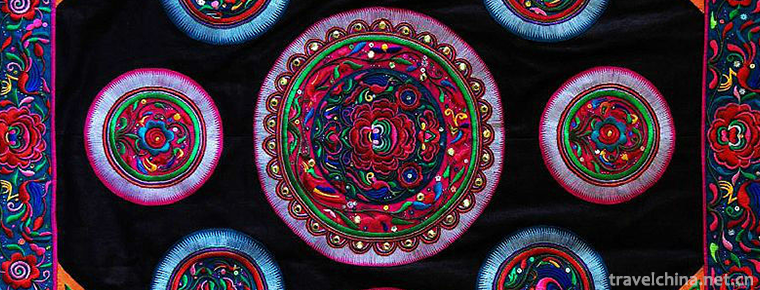
-
Lake Manasarovar
Ma Pang yongcuo is 35 kilometers east of the town of Pu Lan county.
Views: 172 Time 2018-10-12 -
Qianling Scenic Area
Qianling Scenic Area, located in Qianxian County, Xianyang, Shaanxi Province, covers an area of 1002.71 square kilometers. Population: 580,000 (2011), postcode: 713300..
Views: 136 Time 2018-12-22 -
Tianjin Binhai Carrier Theme Park
Tianjin Binhai Aircraft Carrier Theme Park (hereinafter referred to as "Binhai Aircraft Carrier") is located in Hangu Bagua Beach, Binhai New Area, Tianjin City.
Views: 181 Time 2019-02-21 -
Wo Lou dance
Helou Dance is a traditional folk entertainment program in Yunan County, Guangdong Province. It is called "living fossil" in traditional dance. Helou Dance is the product of.
Views: 138 Time 2019-05-02 -
Cutting Copper Dus Cutting Copper
Painting inscriptions on bronze pots, smooth lines; beautiful paintings of mountains and rivers on bronze plates, such as immersion... In many people's eyes, Du's bronze engraving, .
Views: 257 Time 2019-05-09 -
Cooking Skills of Confucian Cuisine
The cooking skill of Confucian cuisine, the traditional handicraft of Qufu City, Shandong Province, is one of the national intangible cultural heritages..
Views: 97 Time 2019-05-09 -
Sizhou opera
Sizhou Opera is one of the four major operas in Anhui Province. Its original name is Lahun Opera. It has a history of more than 200 years. Many people think that it originated in Haizhou, northern Jia.
Views: 120 Time 2019-06-16 -
Xu Wenchangs Story
The story of Xu Wenchang takes the history of the middle and late Ming Dynasty as the background. From the legend story of Xu Wenchang's youth, "Taking things from the pole", it has been tol.
Views: 135 Time 2019-07-09 -
Fobao ancient town
Fubao ancient town is an ancient town with a long history in Hejiang County, Sichuan Province, 42 km away from Hejiang County, Sichuan Province. It is a historical town, a famous cultural town, a tourism town, and an important business town in the junction of Sichuan, Guizhou and Chongqing. It was built in the late yuan and early Ming Dynasty, more than 600 years ago, it is named Fobao, and it is the gateway of national Fobao forest park..
Views: 143 Time 2020-10-16 -
Deyang climate
There are obvious differences in climate between the mountainous area in the northwest and the plain and hilly area in the southeast of Deyang City. The main climatic characteristics are: mild climate, four distinct seasons, abundant rainfall, long frost free period and obvious .
Views: 75 Time 2020-12-14 -
Meishan climate
Meishan city is located in the middle and low latitudes, located in the west of Sichuan Basin and the middle reaches of Minjiang River. It is characterized by the alternation of sea land monsoon every year. It has four distinct seasons, mild climate, abundant rainfall,.
Views: 334 Time 2020-12-18 -
Dazhous tertiary industry
In 2019, the total retail sales of social consumer goods in Dazhou city will reach 98.794 billion yuan, an increase of 11.0%, 0.6 percentage points higher than that of the whole province, ranking the fourth in the province. From the regional perspectiv.
Views: 186 Time 2020-12-20



